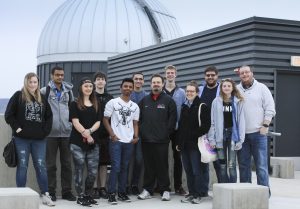Star-gazing
The CWU Astronomy club teaches and explores the mysteries of space: the final frontier
April 13, 2017
 Jack Lambert
Jack Lambert
In the planetarium, located in the Science II building, students sat in black theatre chairs. The Astronomy Club President Jeff Carter and Vice President Mike Brice, sat at the front of the black, round room. Their voices echoed throughout the room as they spoke about upcoming events.
“[What I like about the club] is that everyone is passionate and come from a myriad of different backgrounds,” said Jason Arakawa, a 21-year-old senior majoring in physics with minors in astronomy and mathematics. “Some people are physics and astronomy majors… and some in completely different fields and all are welcome.”
The astronomy club consists of 6 to 18 members. The purpose of the club is to share knowledge about astronomy with those interested in learning. Current club members constantly learn from each other.
“When I was a little kid, I wanted to an astrophysicist. I lived by the ocean and it was always cloudy… the chances of getting outside with a telescope were completely non-existent,” said Carter, a 26-year-old junior and physics major. “When I [came to CWU] and heard about the astronomy club, I wanted to be a part of it.”
Brice, a 21-year-old physics major, was interested in meeting people that liked astronomy when he first attended Central four years ago. He heard that there was an astronomy club and became a member.
“When I first attended the meeting, I felt overwhelmed; I was a very shy freshman,” Brice said. “I never thought I’d be sitting here as vice president or even last year, as president.”
The meetings that Brice attended are significantly different than the meetings now.
The club centered on members doing physics demos while the professor did all the work and handled the telescopes. Brice didn’t like the minimal involvement of students. So when he became the president last year, he changed the rules so that all the club members are involved and able to use equipment.
“When I went to my first meeting last year, I hated it… During winter break, I truly got involved and helped Mike turn [the club around],” Carter said. “We wanted to make this club applicable to people who are not physics majors.”
The club encourages involvement from all club members. The club is open to all students and members of the community.
“We try to remove a lot of the complex math during the meetings…I want to introduce families to astronomy,” said Carter.
When there is clear skies, the club does telescope training on the roof. Club members are taught to use telescopes, binoculars and filters, among other things. Everyone in the club can use the equipment.
The club also hosts Public Star Parties on the last Tuesday of every month. The Public Star Parties feature topics like black holes, planetary science, star formation and observe celestial bodies. The community and students can use the equipment and gaze at the milky way, Jupiter and Mars.
“It’s gratifying when we do the public star parties and you get families… the look on some of the kids’ faces… there’s something about it,” Carter said smiling.

